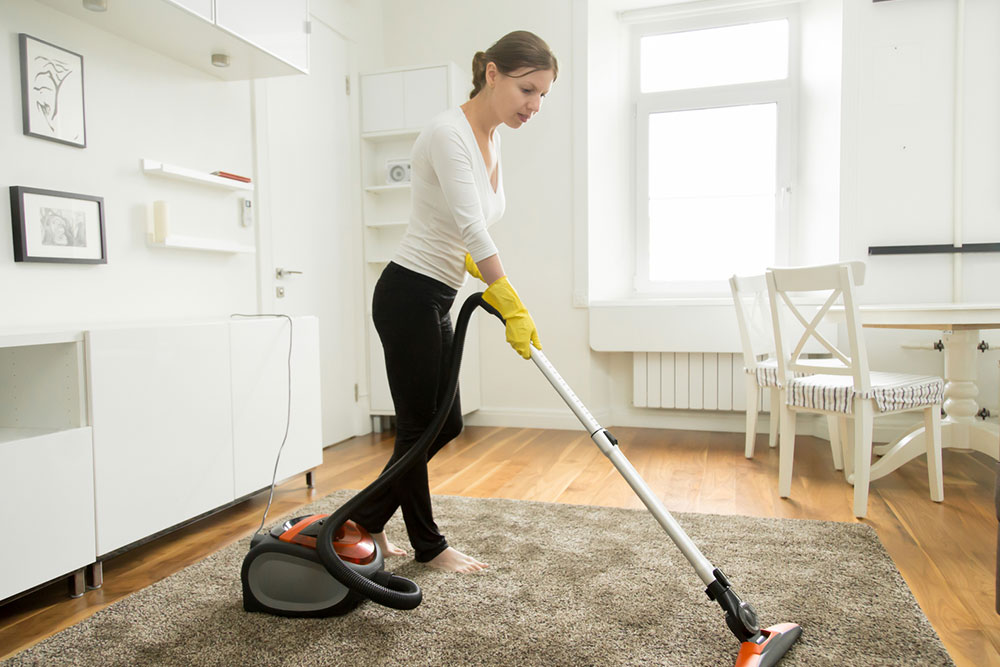9 common carpet cleaning mistakes to avoid

Keeping the home clean is a necessary but huge undertaking. While hard surfaces such as tiles and floors can be relatively easy to maintain, carpets require a lot of tender love and care, much more than one may think. This results in one making common mistakes that could damage the carpet fibers over time or soil them beyond repair. Keep reading to find about 9 carpet cleaning mistakes and simple ways to avoid them:
1. Scrubbing the carpet too much
Vigorously scrubbing stains on a carpet can damage the fibers and cause fraying. This action is more likely to push the stain in rather than remove it. Instead of scrubbing, try using a blotting motion using a cloth or a sponge. Avoid using a colorful cloth here, as it may transfer color. If the stain is too stubborn and won’t lift, call in a professional carpet cleaning service.
2. Using too much water
When it comes to cleaning any surface, most people instinctively reach for water. While this may work for hard surfaces, it may not always be the best choice for upholstery. Using too much water to clean the carpet can make the underfelt wet, making it extremely difficult to dry it off properly. This can cause discoloration, damage carpet fibers, or even become a hotspot for mold growth. Avoid this by using water sparingly during carpet cleaning. Also, give it ample time out in the sun to dry completely.
3. Choosing the wrong carpet cleaner
Don’t be in a rush to buy the most popular carpet cleaner from the store. There are so many types of carpet fabrics, and each one of these requires special care and attention. For each material, there are dedicated chemical cleaners. Take some time to research the type of fabric and the cleaning solution it requires, Also, follow the manufacturer’s directions for the carpet cleaner. If uncertain, one should resort to using a mild all-purpose carpet cleaner.
4. Skipping spot tests
When working with a new cleaning solution, one should begin with a spot test on a hidden patch of carpet (perhaps under the sofa or table). This is because the wrong cleaning solution can cause bleaching or fiber loss. A spot test will give one a better idea of how the cleaning solution will react with the carpet, and soiling a little bit of the upholstery will hurt way less than destroying the whole carpet.
5. Overusing carpet deodorizer
Using a deodorizing powder is an easy hack to make the carpets smell nice without having to put in the effort of cleaning them. However, using it incorrectly or using too much of it can have the opposite effect. Over time, these powders can cause gunky build-up in the fibers of the carpet. They can also leave the fabric looking tacky or dull. If the carpet is cleaned well regularly, it shouldn’t need a deodorizer. Alternatively, a non-toxic odor neutralizer can temporarily help cover up the smell of pet urine or spills on the carpet till the next wash.
6. Acting too slow
While spills are common, they don’t always have to turn into stains, i.e., they should not be left to set, as these become stubborn and difficult to clean over time. In waiting for a spill to dry, one may end up allowing it to get fully soaked into the carpet fibers and affect the padding. This can increase the risk of mold growth and unpleasant odors. So, when dealing with a spill, blot the liquid immediately with a soft cloth to prevent it from seeping into the rug. Remove any food or other particles that may have fallen, as these can cling to the carpet fibers.
7. Overlooking professional carpet cleaning
Cleaning carpets at home with a vacuum or a generic cleaner does not have quite the same effect as professional cleaning. One can keep expensive upholstery looking clean and fresh as new by sending them to professional carpet cleaners from time to time. The time intervals vary on the type of fabric and the amount of traffic on the carpet, but sending it to the cleaners is a sure-shot way of removing any stuck dust, particles, or stains that could damage the carpet.
8. Using the wrong cleaning equipment
Those who are keen on cleaning their carpets at home must pay attention to the equipment they use. Renting the wrong or faulty cleaning equipment could also damage the carpet. If these rental machines are not inspected too often, they may not get rid of the cleaning solutions effectively, which can ruin the carpets due to mold growth and re-soiling. To avoid this from occurring, one should only get equipment from trusted or reputable rental companies. One should also ask them for clear instructions to use the machine to the best of its capabilities.
9. Cleaning or vacuuming too often
While not cleaning is a major faux pas when it comes to carpet maintenance, going overboard with cleanup can also affect the quality of the carpet. For instance, excessive use of chemical cleaning solutions and power vacs can make the carpet fibers thin out or make their colors fade. As a general rule of thumb, most carpet manufacturers recommend doing a weekly surface cleanup. This can be supported by a deep cleaning once every 12 to 18 months.


